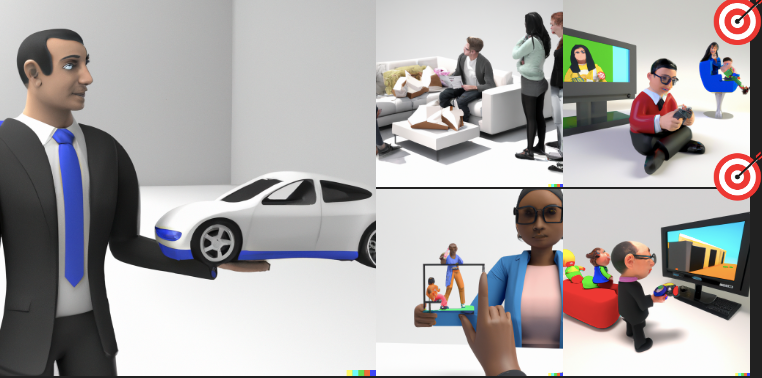Usage of 3d art and 3d models in marketing

Introduction:
In today's fast-paced world, marketing has become an essential aspect of any business. As competition grows, companies need to find innovative ways to reach their target audience and stand out from the crowd. One such innovative way is the usage of 3D art and 3D models in marketing. 3D art and models provide a realistic and immersive experience, which is more engaging and effective in catching the viewer's attention than traditional 2D images. This blog will explore the various applications of 3D art and models in marketing and how they can help businesses enhance their marketing campaigns.
Marketing has come a long way from the days of simple print advertisements and billboard ads. With the advancement of technology, businesses are constantly finding new and innovative ways to capture the attention of their target audience. One such method that has gained a lot of popularity in recent years is the usage of 3D art and 3D models in marketing campaigns. From product packaging to in-store displays, 3D art has the potential to create an engaging and immersive experience for customers, making it an effective tool for businesses looking to stand out from the competition.
For instance, companies like Nike and Adidas have used 3D art to showcase their products in an innovative way. Nike created a virtual reality experience called "The Neymar Jr. Effect" where customers could experience what it's like to be a professional soccer player. Adidas created an augmented reality experience where customers could try on their shoes virtually before purchasing.
In addition, 3D art and 3D models have also been used in animation and gaming to promote products and services. For example, the fast-food chain KFC created a video game where players could collect chicken and other items for points. This game was not only entertaining, but it also helped to promote their brand and products. The usage of 3D art and 3D models in marketing campaigns can also lead to increased brand recognition. By creating unique and memorable visuals, businesses can establish themselves as cutting-edge and reliable, which can lead to higher brand recall and recognition.
Similarly, incorporating 3D art and 3D models in PR campaigns can be a game-changer for businesses looking to make a lasting impact with their PR strategies. With the help of 3D visuals, businesses can showcase their products and services in a more immersive way, ultimately capturing the attention of their target audience. This can be particularly helpful in product launches or announcements, where creating buzz and excitement is key. For example, a tech company could use 3D models to unveil a new product in a virtual event, allowing customers to experience the product in a more engaging way. The possibilities are endless with 3D art and models, making it an essential tool for any modern PR campaign. Overall, the potential of 3D art and 3D models in marketing campaigns is vast, and businesses should consider utilizing this technology to create more engaging experiences for their customers.
The Top 5 Benefits of Using 3D Art in Your Marketing
There are many benefits of using 3D art in your marketing, including:
A More Engaging Experience
3D art is more engaging than traditional 2D art, which can help you capture attention and interest.
In today’s world, 3D art is often used in marketing and advertising to create more engaging experiences for consumers. From product packaging to in-store displays, businesses are using 3D art to capture attention and stand out from the competition.
A More Realistic Perspective
Using 3D art in your marketing also offers the advantage of a more realistic perspective. When your audience sees products or displays in 3D, they can get a better idea of how they would look in their own environment. This can help you to boost sales, as customers are more likely to feel more confident about investing in something they can visualize more accurately.
Additionally, 3D art also offers more creative freedom. With 2D art, there are often limited options when it comes to representing an idea or concept in a visually appealing way. But with 3D art, you can use different materials and textures to create an immersive experience for your audience. This can be especially helpful when you’re trying to promote a product or service in a new and innovative way.
Increased Brand Recognition
3D art is more memorable than 2D art, which can help your brand and products stay top of mind.
One of the most underrated benefits of using 3D art in your marketing is increased brand recognition. When customers see products or displays rendered in 3D, they recognize the image as unique and associate it with your brand. This can lead to higher brand recall and recognition, giving you an edge over the competition and helping you to maximize the effectiveness of your advertising campaigns.
The advantage of 3D art in marketing is that it helps to establish your brand as cutting-edge and reliable. As 3D art conveys a sense of realism and immersion, customers are more likely to trust your brand, since it appears up-to-date. As such, investing in 3D art in your marketing can help drive sales by developing trust between you and your customers.
Greater Connection to Customers
In addition to increased brand recognition, 3D art has powerful potential to create stronger connections with customers. People are visually attracted to visualizations and because of its high level of detail and realism, 3D art helps capture the customer’s attention more easily.
3D art offers greater flexibility than 2D art, which means you can create a wide variety of looks and styles to suit your needs. By creating interactive 3D art, customers can actually experience what it is like to use your product. This adds an element of fun to the customer’s experience and it makes them more likely to remember your brand. This can be a great way of driving sales and customer loyalty.
Moreover, 3D art can help you create longer-lasting impressions on customers that can help you stand out from your competition. As customers view your 3D visuals, they will gain a better understanding of your brand, which can result in deeper level of customer engagement.
Unlimited Potential
3D art also offers unlimited potential in terms of marketing. This type of technology can be used in a variety of ways – from creating vivid visuals for TV and magazine advertisements to producing highly detailed product photo updates for eCommerce websites.
3D art can also be used for animation, virtual reality, augmented reality, and even gaming. By utilizing 3D art for these types of projects, you can engage your audience and create an immersive environment for them. 3D art also leads to increased ROI due to its engaging
When it comes to physical joinery or craft, 3D art can be used to create an accurate 3D model for a product as 1:1 scale. This technology is useful for engraving, injection moulding, and die casting processes. Not only does this save time, but it also offers more control in terms of design and product development.
Overall, 3D art can add a lot of value to your marketing and product development processes. It can help you promote your brand better and create a stronger connection with customers. Moreover, the possibilities are endless when it comes to what you can do with 3D art.
3D Product Modeling in E-Commerce
In recent years, 3D product models have become increasingly popular in e-commerce. By utilizing these models businesses can create highly detailed, interactive models of their products, allowing customers to get a better sense of the product's size, shape, and features before making a purchase.
One of the biggest advantages of 3D product models in e-commerce is the ability to enhance the customer's online shopping experience. For example, a furniture retailer can create 3D models of their products, allowing customers to see how a sofa or chair would look in their own living room before making a purchase. This can help to reduce the number of returns and increase customer satisfaction.
Additionally, 3D product models can be especially useful for industries that sell customizable products, such as jewelry or eyewear. By creating 3D models of different variations, customers can see exactly what their customized product will look like before placing an order. This not only helps to increase customer confidence in their purchase but also reduces the likelihood of returns or exchanges due to dissatisfaction.
Another industry that has benefited greatly from the use of 3D product models in e-commerce is the automotive industry. Companies such as Porsche have implemented 3D product models on their websites, allowing customers to explore the interior and exterior of their vehicles from all angles. This immersive experience helps to increase customer engagement and can lead to higher sales.
Overall, the usage of 3D product models in e-commerce offers numerous advantages, including enhanced customer experience, increased customer confidence, and reduced return rates. As technology continues to evolve, it's likely that more industries will adopt 3D product models as a standard part of their e-commerce strategy.
3D models and art helps in gaining Unlimited potential
Yes, 3D art and models offer unlimited potential in marketing function across various industries. One of the biggest advantages of 3D modeling is the ability to create a virtual product that can be used for a wide range of applications. For example, in the fashion industry, 3D models can be used to create virtual try-on experiences for customers to see how clothes fit and look on different body types.
Another example is in the automotive industry, where 3D models can be used for prototyping and design testing. Companies can create 3D models of car parts and test them virtually, making adjustments and improvements before moving to physical production.
By showcasing products in 3D, customers can get a better sense of what they're buying and how it will look in real life. This can lead to increased sales and reduced returns. The potential applications of 3D art and models are vast and varied, offering a wealth of opportunities to businesses in different industries. By embracing this technology, companies can stay ahead of the curve and create innovative products and experiences for their customers.
Types of 3d art and its types applicable to marketing field
There are several types of 3D art, characters and designs that can be used in the marketing field. One of the most popular types is architectural visualization. This involves creating 3D models of buildings or spaces to showcase how they will look in real life. It's commonly used by architects, real estate agents, and property developers to market their projects. Another type of 3D art that's gaining popularity in marketing is product visualization. This involves creating 3D models of products to showcase their features and functionality. It's commonly used in e-commerce to help customers visualize products before making a purchase.
Character modeling is another type of 3D art that's used in marketing. It involves creating 3D models of characters or avatars that can be used in advertising campaigns, video games, or animated videos. This helps create a memorable and engaging experience for customers.
3D printing is also becoming more common in marketing. It allows businesses to create physical models of their products or marketing materials, such as custom packaging or promotional items. This adds a tactile element to marketing that can help create a lasting impression on customers. The types of 3D art that are applicable to the marketing field are vast and varied. By utilizing these tools, businesses can create more engaging and immersive experiences for their customers, ultimately leading to increased brand awareness and sales.
Impact of 3D Art and Models in Successful Marketing Campaigns: A few Case Studies
There are several examples of successful marketing campaigns that have utilized 3D art and models to create an impact on their target audience. One such campaign was by IKEA, the furniture retailer. IKEA used 3D product modeling to create an interactive online catalog that allowed customers to visualize how their furniture would look in their homes. The campaign was a huge success as customers were able to see how the furniture would fit and complement their homes before making a purchase.
Another example is from the automotive industry, where Audi used 3D modeling to create a virtual showroom. The showroom allowed customers to experience the look and feel of Audi's latest models in a virtual environment, enabling them to customize their chosen car and explore its features before making a purchase. The campaign resulted in a significant increase in online engagement and generated a positive buzz around the brand.
Similarly in the fashion industry, 3D modeling has been used to create realistic virtual fashion shows. Brands like Burberry, Louis Vuitton, and Gucci have incorporated 3D models and designs to showcase their collections and provide customers with an immersive experience. This approach has proved to be effective in increasing customer engagement and providing a more personalized shopping experience.
How to use 3D art in marketing
Using 3D art in marketing can be a great way to engage with your target audience and create a lasting impact. Here are some ways to effectively use 3D art in marketing:
Create product visuals:
Use 3D modeling to create stunning visuals of your products. This can be particularly helpful for industries such as e-commerce where customers cannot physically touch or feel the product. 3D product visuals can help customers get a better understanding of the product's features and design, leading to increased conversions.
Create animated videos:
3D art can also be used to create animated videos that showcase your product or service. These videos can be used for advertising on social media platforms, websites, or even on TV. Animated videos can be an effective way to showcase your product's unique features and stand out from competitors.
Create interactive experiences:
Another way to use 3D art in marketing is to create interactive experiences for customers. This can be in the form of interactive product demos, virtual tours, or even augmented reality experiences. These interactive experiences can help customers engage with your brand in a unique and memorable way.
Use 3D art for branding:
3D art can also be used to create visually striking branding materials such as logos, packaging, and marketing collateral. Using 3D art for branding can help your brand stand out and make a lasting impression on customers.
The key to using 3D art in marketing is to be creative and think outside the box. By leveraging the power of 3D art, you can create unique and memorable marketing campaigns that engage with your target audience and drive results.
Potential challenges and limitations of using 3D art in marketing.
While there are many benefits to using 3D art in marketing, there are also some potential challenges and limitations to keep in mind. One of the primary challenges is the cost involved in creating high-quality 3D art. This can be particularly true for smaller businesses or startups that may not have the budget to invest in expensive software or professional artists.
Another challenge is the technical expertise required to create high-quality 3D models. While there are many resources available to help businesses learn how to create 3D models, it can still take time and practice to create models that look professional and realistic. Additionally, creating 3D models can be time-consuming, which can be a limitation for businesses that need to produce content quickly.
My3dmodels understands that one of the biggest challenges in using 3D art for marketing is the technical expertise required to create high-quality models. Although there are numerous resources available to learn 3D modeling, it still takes practice and time to produce models that look professional and realistic. Additionally, creating 3D models can be a time-consuming process, which can limit the ability of businesses to produce 3D content quickly. However, My3dmodels has a team of skilled 3D professionals who can create high-quality 3D models for business growth, saving them both time and money.
Another potential limitation of using 3D art in marketing is the accessibility of the content. While many consumers have access to devices and platforms that can display 3D models, not all consumers may be able to view 3D content, which could limit the reach of marketing campaigns that rely on 3D art. Additionally, not all industries or products may lend themselves well to 3D modeling, which could limit the applicability of 3D art in certain marketing campaigns.
Despite these potential challenges and limitations, however, the benefits of using 3D art in marketing can still make it a valuable tool for businesses looking to stand out in a crowded marketplace. By understanding the potential challenges and limitations of using 3D art in marketing, businesses can make informed decisions about whether or not 3D art is the right choice for their marketing campaigns.
Conclusion:
In conclusion, 3D art and models are revolutionizing the way businesses approach marketing. They offer unlimited potential and can create a significant impact on marketing campaigns, making them more engaging and memorable. Although there are some challenges and limitations in using 3D art, with the help of professional 3D model makers like My3dmodels, businesses can overcome these obstacles and produce high-quality 3D content. In a world where content is king, using 3D art and models can be the key to standing out and succeeding in the competitive landscape of marketing.




